Financial Management Report: Financial Decision Making and Strategies
VerifiedAdded on 2023/01/13
|10
|2582
|96
Report
AI Summary
This financial management report delves into various aspects of financial decision-making within the context of Brightsun Travel. It begins by outlining different formal and informal approaches used in decision-making, followed by an exploration of key financial principles. The report examines the role of management accountants and the significance of accounting control systems. It further evaluates the importance of financial decision-making for long-term sustainability. The report incorporates ratio analysis, assessing the financial health of Brightsun Travel, including gross profit margin, net profit margin, current ratio, return on equity, and debt-equity ratio. Additionally, it discusses investment appraisal techniques such as NPV, payback period, and average rate of return. The report concludes by emphasizing the role of accountants and financial decision-making in supporting long-term financial sustainability. The report uses data to inform strategic and operational decisions.

Financial
Management
Management
Paraphrase This Document
Need a fresh take? Get an instant paraphrase of this document with our AI Paraphraser
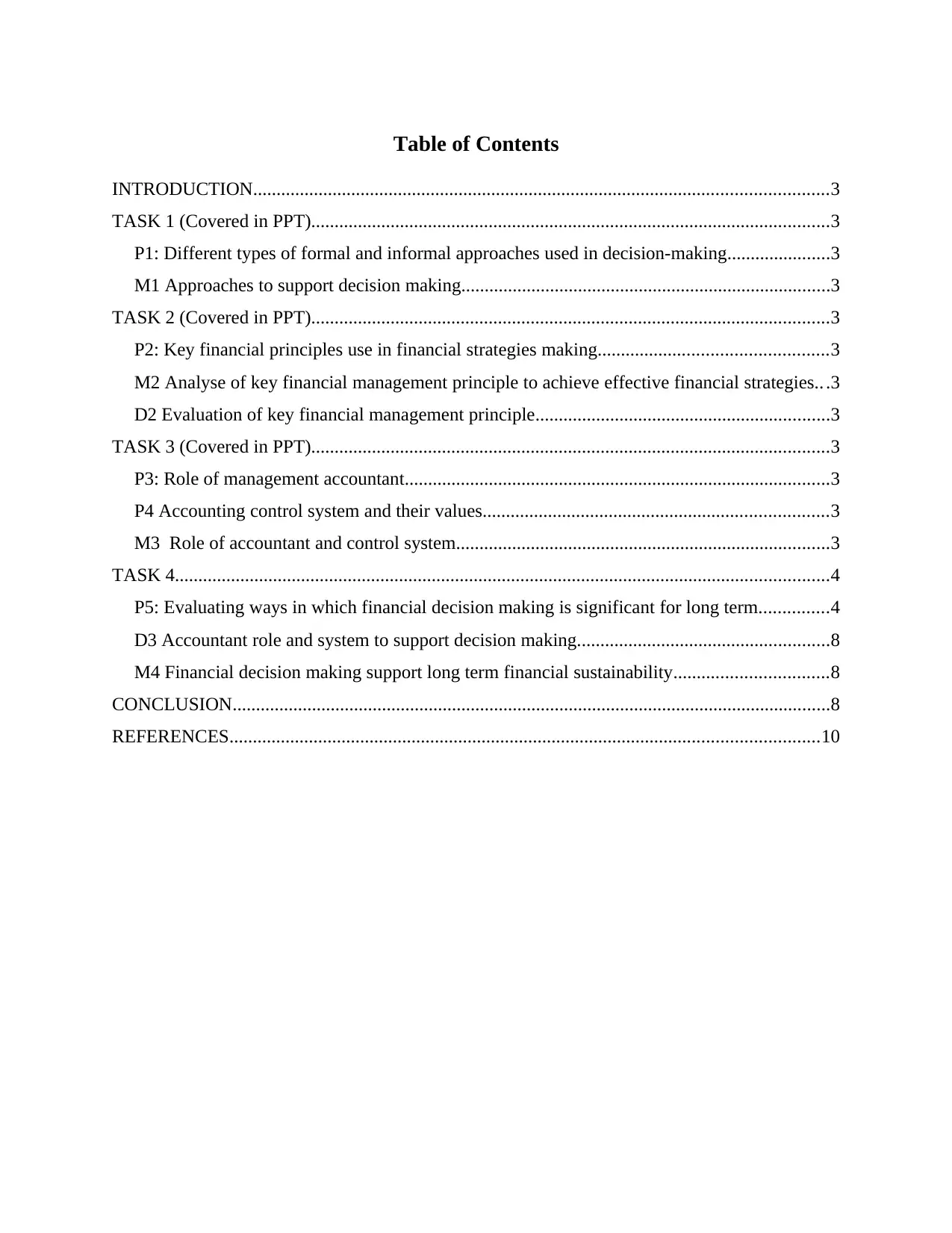
Table of Contents
INTRODUCTION...........................................................................................................................3
TASK 1 (Covered in PPT)...............................................................................................................3
P1: Different types of formal and informal approaches used in decision-making......................3
M1 Approaches to support decision making...............................................................................3
TASK 2 (Covered in PPT)...............................................................................................................3
P2: Key financial principles use in financial strategies making.................................................3
M2 Analyse of key financial management principle to achieve effective financial strategies.. .3
D2 Evaluation of key financial management principle...............................................................3
TASK 3 (Covered in PPT)...............................................................................................................3
P3: Role of management accountant...........................................................................................3
P4 Accounting control system and their values..........................................................................3
M3 Role of accountant and control system................................................................................3
TASK 4............................................................................................................................................4
P5: Evaluating ways in which financial decision making is significant for long term...............4
D3 Accountant role and system to support decision making......................................................8
M4 Financial decision making support long term financial sustainability.................................8
CONCLUSION................................................................................................................................8
REFERENCES..............................................................................................................................10
INTRODUCTION...........................................................................................................................3
TASK 1 (Covered in PPT)...............................................................................................................3
P1: Different types of formal and informal approaches used in decision-making......................3
M1 Approaches to support decision making...............................................................................3
TASK 2 (Covered in PPT)...............................................................................................................3
P2: Key financial principles use in financial strategies making.................................................3
M2 Analyse of key financial management principle to achieve effective financial strategies.. .3
D2 Evaluation of key financial management principle...............................................................3
TASK 3 (Covered in PPT)...............................................................................................................3
P3: Role of management accountant...........................................................................................3
P4 Accounting control system and their values..........................................................................3
M3 Role of accountant and control system................................................................................3
TASK 4............................................................................................................................................4
P5: Evaluating ways in which financial decision making is significant for long term...............4
D3 Accountant role and system to support decision making......................................................8
M4 Financial decision making support long term financial sustainability.................................8
CONCLUSION................................................................................................................................8
REFERENCES..............................................................................................................................10
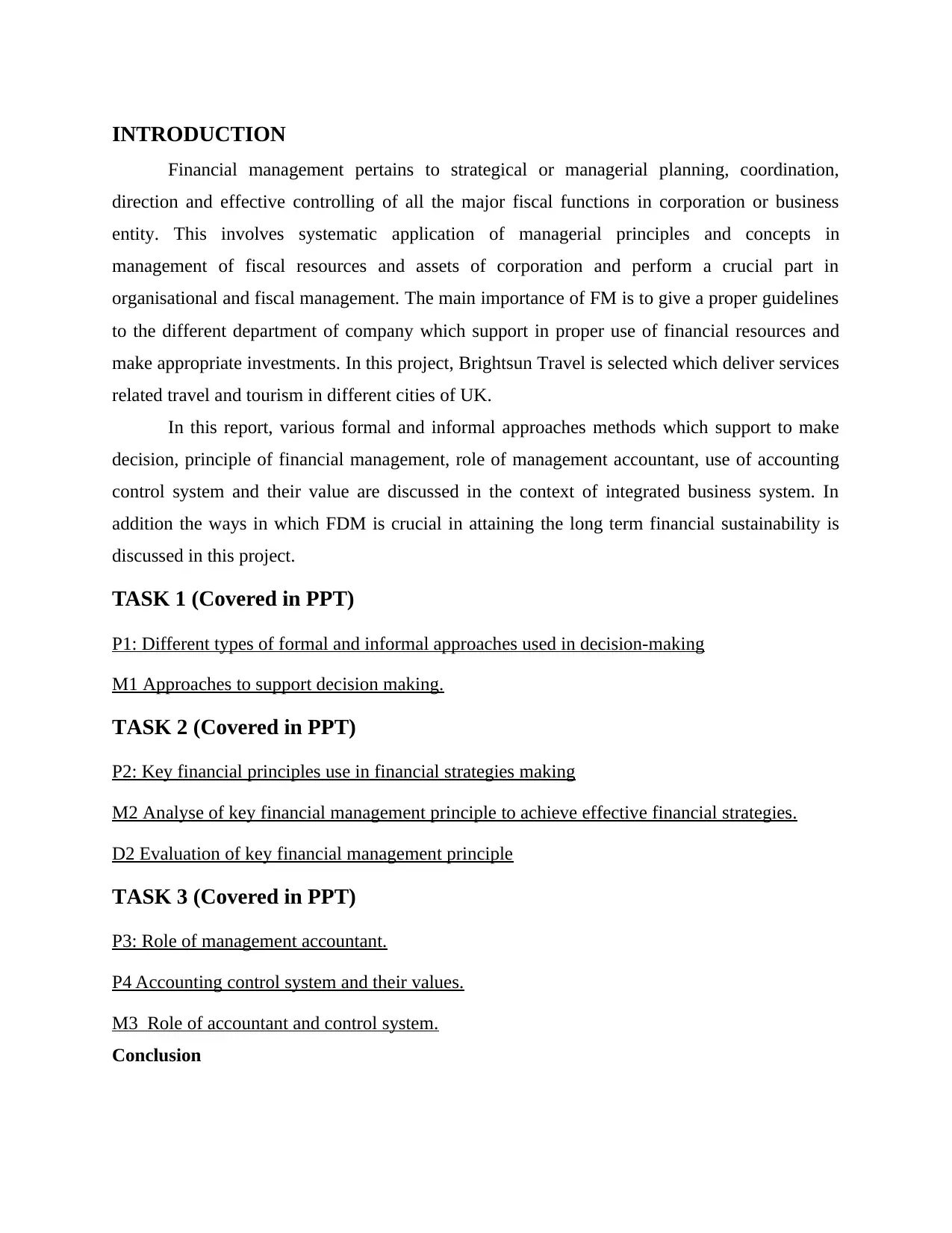
INTRODUCTION
Financial management pertains to strategical or managerial planning, coordination,
direction and effective controlling of all the major fiscal functions in corporation or business
entity. This involves systematic application of managerial principles and concepts in
management of fiscal resources and assets of corporation and perform a crucial part in
organisational and fiscal management. The main importance of FM is to give a proper guidelines
to the different department of company which support in proper use of financial resources and
make appropriate investments. In this project, Brightsun Travel is selected which deliver services
related travel and tourism in different cities of UK.
In this report, various formal and informal approaches methods which support to make
decision, principle of financial management, role of management accountant, use of accounting
control system and their value are discussed in the context of integrated business system. In
addition the ways in which FDM is crucial in attaining the long term financial sustainability is
discussed in this project.
TASK 1 (Covered in PPT)
P1: Different types of formal and informal approaches used in decision-making
M1 Approaches to support decision making.
TASK 2 (Covered in PPT)
P2: Key financial principles use in financial strategies making
M2 Analyse of key financial management principle to achieve effective financial strategies.
D2 Evaluation of key financial management principle
TASK 3 (Covered in PPT)
P3: Role of management accountant.
P4 Accounting control system and their values.
M3 Role of accountant and control system.
Conclusion
Financial management pertains to strategical or managerial planning, coordination,
direction and effective controlling of all the major fiscal functions in corporation or business
entity. This involves systematic application of managerial principles and concepts in
management of fiscal resources and assets of corporation and perform a crucial part in
organisational and fiscal management. The main importance of FM is to give a proper guidelines
to the different department of company which support in proper use of financial resources and
make appropriate investments. In this project, Brightsun Travel is selected which deliver services
related travel and tourism in different cities of UK.
In this report, various formal and informal approaches methods which support to make
decision, principle of financial management, role of management accountant, use of accounting
control system and their value are discussed in the context of integrated business system. In
addition the ways in which FDM is crucial in attaining the long term financial sustainability is
discussed in this project.
TASK 1 (Covered in PPT)
P1: Different types of formal and informal approaches used in decision-making
M1 Approaches to support decision making.
TASK 2 (Covered in PPT)
P2: Key financial principles use in financial strategies making
M2 Analyse of key financial management principle to achieve effective financial strategies.
D2 Evaluation of key financial management principle
TASK 3 (Covered in PPT)
P3: Role of management accountant.
P4 Accounting control system and their values.
M3 Role of accountant and control system.
Conclusion
⊘ This is a preview!⊘
Do you want full access?
Subscribe today to unlock all pages.

Trusted by 1+ million students worldwide
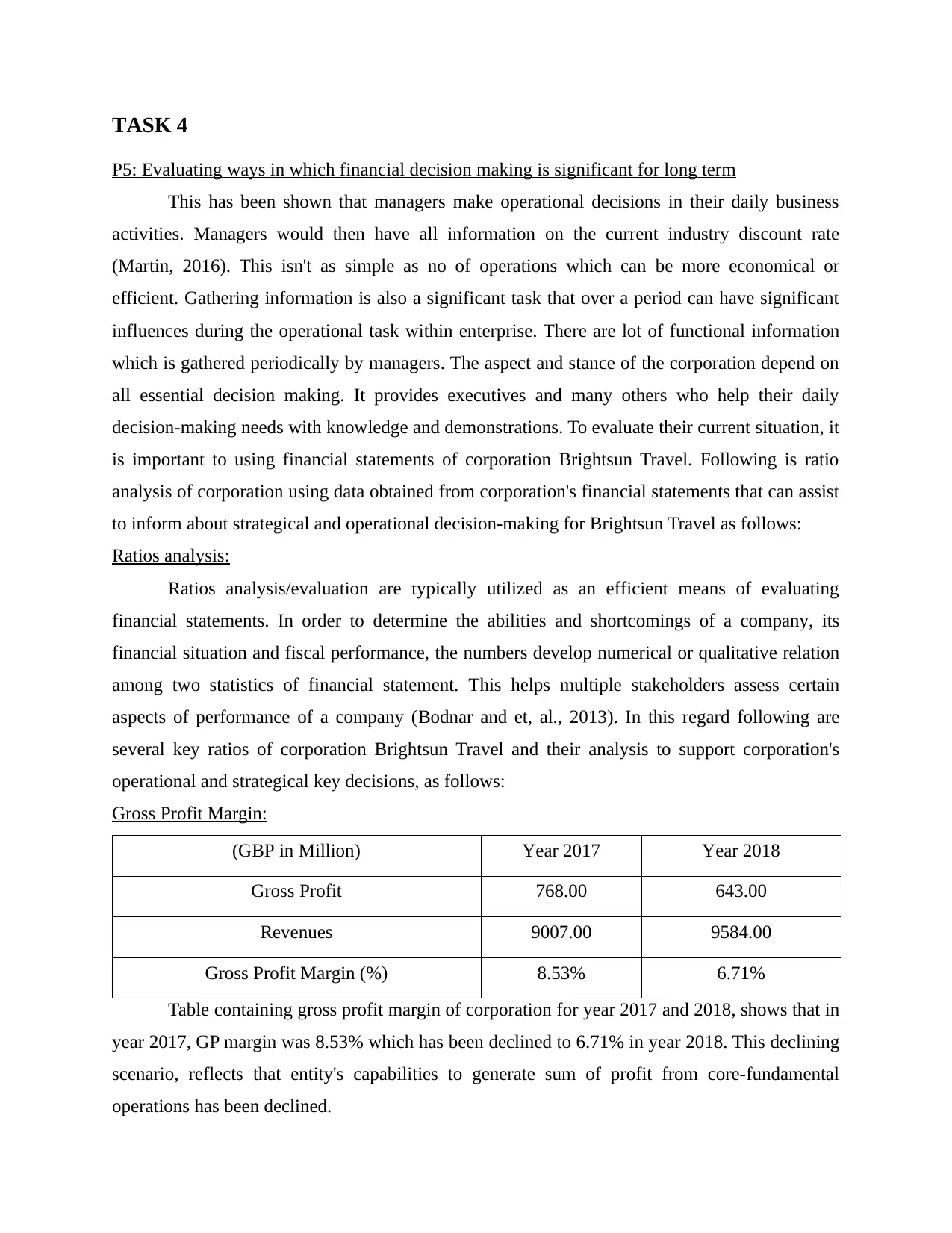
TASK 4
P5: Evaluating ways in which financial decision making is significant for long term
This has been shown that managers make operational decisions in their daily business
activities. Managers would then have all information on the current industry discount rate
(Martin, 2016). This isn't as simple as no of operations which can be more economical or
efficient. Gathering information is also a significant task that over a period can have significant
influences during the operational task within enterprise. There are lot of functional information
which is gathered periodically by managers. The aspect and stance of the corporation depend on
all essential decision making. It provides executives and many others who help their daily
decision-making needs with knowledge and demonstrations. To evaluate their current situation, it
is important to using financial statements of corporation Brightsun Travel. Following is ratio
analysis of corporation using data obtained from corporation's financial statements that can assist
to inform about strategical and operational decision-making for Brightsun Travel as follows:
Ratios analysis:
Ratios analysis/evaluation are typically utilized as an efficient means of evaluating
financial statements. In order to determine the abilities and shortcomings of a company, its
financial situation and fiscal performance, the numbers develop numerical or qualitative relation
among two statistics of financial statement. This helps multiple stakeholders assess certain
aspects of performance of a company (Bodnar and et, al., 2013). In this regard following are
several key ratios of corporation Brightsun Travel and their analysis to support corporation's
operational and strategical key decisions, as follows:
Gross Profit Margin:
(GBP in Million) Year 2017 Year 2018
Gross Profit 768.00 643.00
Revenues 9007.00 9584.00
Gross Profit Margin (%) 8.53% 6.71%
Table containing gross profit margin of corporation for year 2017 and 2018, shows that in
year 2017, GP margin was 8.53% which has been declined to 6.71% in year 2018. This declining
scenario, reflects that entity's capabilities to generate sum of profit from core-fundamental
operations has been declined.
P5: Evaluating ways in which financial decision making is significant for long term
This has been shown that managers make operational decisions in their daily business
activities. Managers would then have all information on the current industry discount rate
(Martin, 2016). This isn't as simple as no of operations which can be more economical or
efficient. Gathering information is also a significant task that over a period can have significant
influences during the operational task within enterprise. There are lot of functional information
which is gathered periodically by managers. The aspect and stance of the corporation depend on
all essential decision making. It provides executives and many others who help their daily
decision-making needs with knowledge and demonstrations. To evaluate their current situation, it
is important to using financial statements of corporation Brightsun Travel. Following is ratio
analysis of corporation using data obtained from corporation's financial statements that can assist
to inform about strategical and operational decision-making for Brightsun Travel as follows:
Ratios analysis:
Ratios analysis/evaluation are typically utilized as an efficient means of evaluating
financial statements. In order to determine the abilities and shortcomings of a company, its
financial situation and fiscal performance, the numbers develop numerical or qualitative relation
among two statistics of financial statement. This helps multiple stakeholders assess certain
aspects of performance of a company (Bodnar and et, al., 2013). In this regard following are
several key ratios of corporation Brightsun Travel and their analysis to support corporation's
operational and strategical key decisions, as follows:
Gross Profit Margin:
(GBP in Million) Year 2017 Year 2018
Gross Profit 768.00 643.00
Revenues 9007.00 9584.00
Gross Profit Margin (%) 8.53% 6.71%
Table containing gross profit margin of corporation for year 2017 and 2018, shows that in
year 2017, GP margin was 8.53% which has been declined to 6.71% in year 2018. This declining
scenario, reflects that entity's capabilities to generate sum of profit from core-fundamental
operations has been declined.
Paraphrase This Document
Need a fresh take? Get an instant paraphrase of this document with our AI Paraphraser
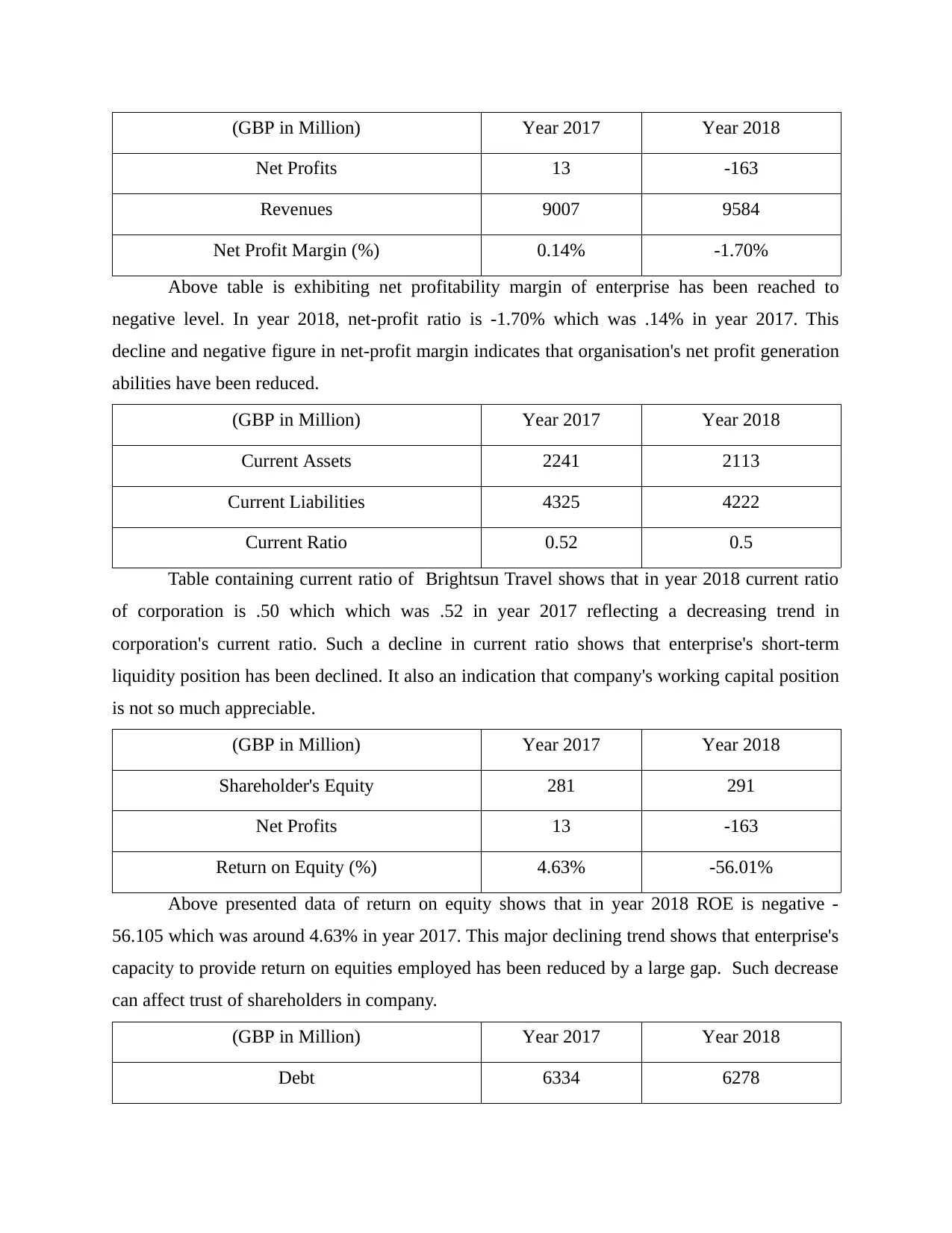
(GBP in Million) Year 2017 Year 2018
Net Profits 13 -163
Revenues 9007 9584
Net Profit Margin (%) 0.14% -1.70%
Above table is exhibiting net profitability margin of enterprise has been reached to
negative level. In year 2018, net-profit ratio is -1.70% which was .14% in year 2017. This
decline and negative figure in net-profit margin indicates that organisation's net profit generation
abilities have been reduced.
(GBP in Million) Year 2017 Year 2018
Current Assets 2241 2113
Current Liabilities 4325 4222
Current Ratio 0.52 0.5
Table containing current ratio of Brightsun Travel shows that in year 2018 current ratio
of corporation is .50 which which was .52 in year 2017 reflecting a decreasing trend in
corporation's current ratio. Such a decline in current ratio shows that enterprise's short-term
liquidity position has been declined. It also an indication that company's working capital position
is not so much appreciable.
(GBP in Million) Year 2017 Year 2018
Shareholder's Equity 281 291
Net Profits 13 -163
Return on Equity (%) 4.63% -56.01%
Above presented data of return on equity shows that in year 2018 ROE is negative -
56.105 which was around 4.63% in year 2017. This major declining trend shows that enterprise's
capacity to provide return on equities employed has been reduced by a large gap. Such decrease
can affect trust of shareholders in company.
(GBP in Million) Year 2017 Year 2018
Debt 6334 6278
Net Profits 13 -163
Revenues 9007 9584
Net Profit Margin (%) 0.14% -1.70%
Above table is exhibiting net profitability margin of enterprise has been reached to
negative level. In year 2018, net-profit ratio is -1.70% which was .14% in year 2017. This
decline and negative figure in net-profit margin indicates that organisation's net profit generation
abilities have been reduced.
(GBP in Million) Year 2017 Year 2018
Current Assets 2241 2113
Current Liabilities 4325 4222
Current Ratio 0.52 0.5
Table containing current ratio of Brightsun Travel shows that in year 2018 current ratio
of corporation is .50 which which was .52 in year 2017 reflecting a decreasing trend in
corporation's current ratio. Such a decline in current ratio shows that enterprise's short-term
liquidity position has been declined. It also an indication that company's working capital position
is not so much appreciable.
(GBP in Million) Year 2017 Year 2018
Shareholder's Equity 281 291
Net Profits 13 -163
Return on Equity (%) 4.63% -56.01%
Above presented data of return on equity shows that in year 2018 ROE is negative -
56.105 which was around 4.63% in year 2017. This major declining trend shows that enterprise's
capacity to provide return on equities employed has been reduced by a large gap. Such decrease
can affect trust of shareholders in company.
(GBP in Million) Year 2017 Year 2018
Debt 6334 6278
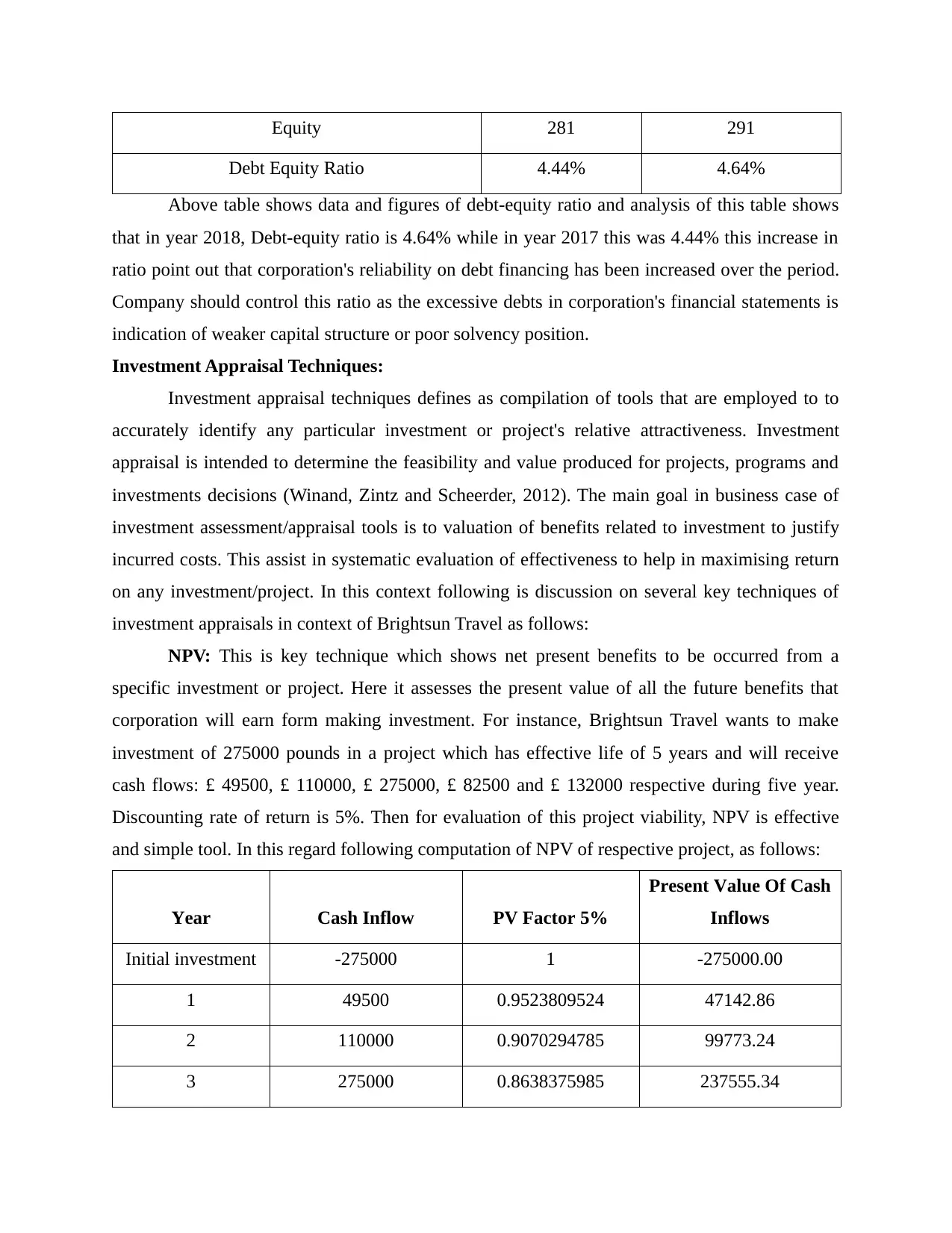
Equity 281 291
Debt Equity Ratio 4.44% 4.64%
Above table shows data and figures of debt-equity ratio and analysis of this table shows
that in year 2018, Debt-equity ratio is 4.64% while in year 2017 this was 4.44% this increase in
ratio point out that corporation's reliability on debt financing has been increased over the period.
Company should control this ratio as the excessive debts in corporation's financial statements is
indication of weaker capital structure or poor solvency position.
Investment Appraisal Techniques:
Investment appraisal techniques defines as compilation of tools that are employed to to
accurately identify any particular investment or project's relative attractiveness. Investment
appraisal is intended to determine the feasibility and value produced for projects, programs and
investments decisions (Winand, Zintz and Scheerder, 2012). The main goal in business case of
investment assessment/appraisal tools is to valuation of benefits related to investment to justify
incurred costs. This assist in systematic evaluation of effectiveness to help in maximising return
on any investment/project. In this context following is discussion on several key techniques of
investment appraisals in context of Brightsun Travel as follows:
NPV: This is key technique which shows net present benefits to be occurred from a
specific investment or project. Here it assesses the present value of all the future benefits that
corporation will earn form making investment. For instance, Brightsun Travel wants to make
investment of 275000 pounds in a project which has effective life of 5 years and will receive
cash flows: £ 49500, £ 110000, £ 275000, £ 82500 and £ 132000 respective during five year.
Discounting rate of return is 5%. Then for evaluation of this project viability, NPV is effective
and simple tool. In this regard following computation of NPV of respective project, as follows:
Year Cash Inflow PV Factor 5%
Present Value Of Cash
Inflows
Initial investment -275000 1 -275000.00
1 49500 0.9523809524 47142.86
2 110000 0.9070294785 99773.24
3 275000 0.8638375985 237555.34
Debt Equity Ratio 4.44% 4.64%
Above table shows data and figures of debt-equity ratio and analysis of this table shows
that in year 2018, Debt-equity ratio is 4.64% while in year 2017 this was 4.44% this increase in
ratio point out that corporation's reliability on debt financing has been increased over the period.
Company should control this ratio as the excessive debts in corporation's financial statements is
indication of weaker capital structure or poor solvency position.
Investment Appraisal Techniques:
Investment appraisal techniques defines as compilation of tools that are employed to to
accurately identify any particular investment or project's relative attractiveness. Investment
appraisal is intended to determine the feasibility and value produced for projects, programs and
investments decisions (Winand, Zintz and Scheerder, 2012). The main goal in business case of
investment assessment/appraisal tools is to valuation of benefits related to investment to justify
incurred costs. This assist in systematic evaluation of effectiveness to help in maximising return
on any investment/project. In this context following is discussion on several key techniques of
investment appraisals in context of Brightsun Travel as follows:
NPV: This is key technique which shows net present benefits to be occurred from a
specific investment or project. Here it assesses the present value of all the future benefits that
corporation will earn form making investment. For instance, Brightsun Travel wants to make
investment of 275000 pounds in a project which has effective life of 5 years and will receive
cash flows: £ 49500, £ 110000, £ 275000, £ 82500 and £ 132000 respective during five year.
Discounting rate of return is 5%. Then for evaluation of this project viability, NPV is effective
and simple tool. In this regard following computation of NPV of respective project, as follows:
Year Cash Inflow PV Factor 5%
Present Value Of Cash
Inflows
Initial investment -275000 1 -275000.00
1 49500 0.9523809524 47142.86
2 110000 0.9070294785 99773.24
3 275000 0.8638375985 237555.34
⊘ This is a preview!⊘
Do you want full access?
Subscribe today to unlock all pages.

Trusted by 1+ million students worldwide
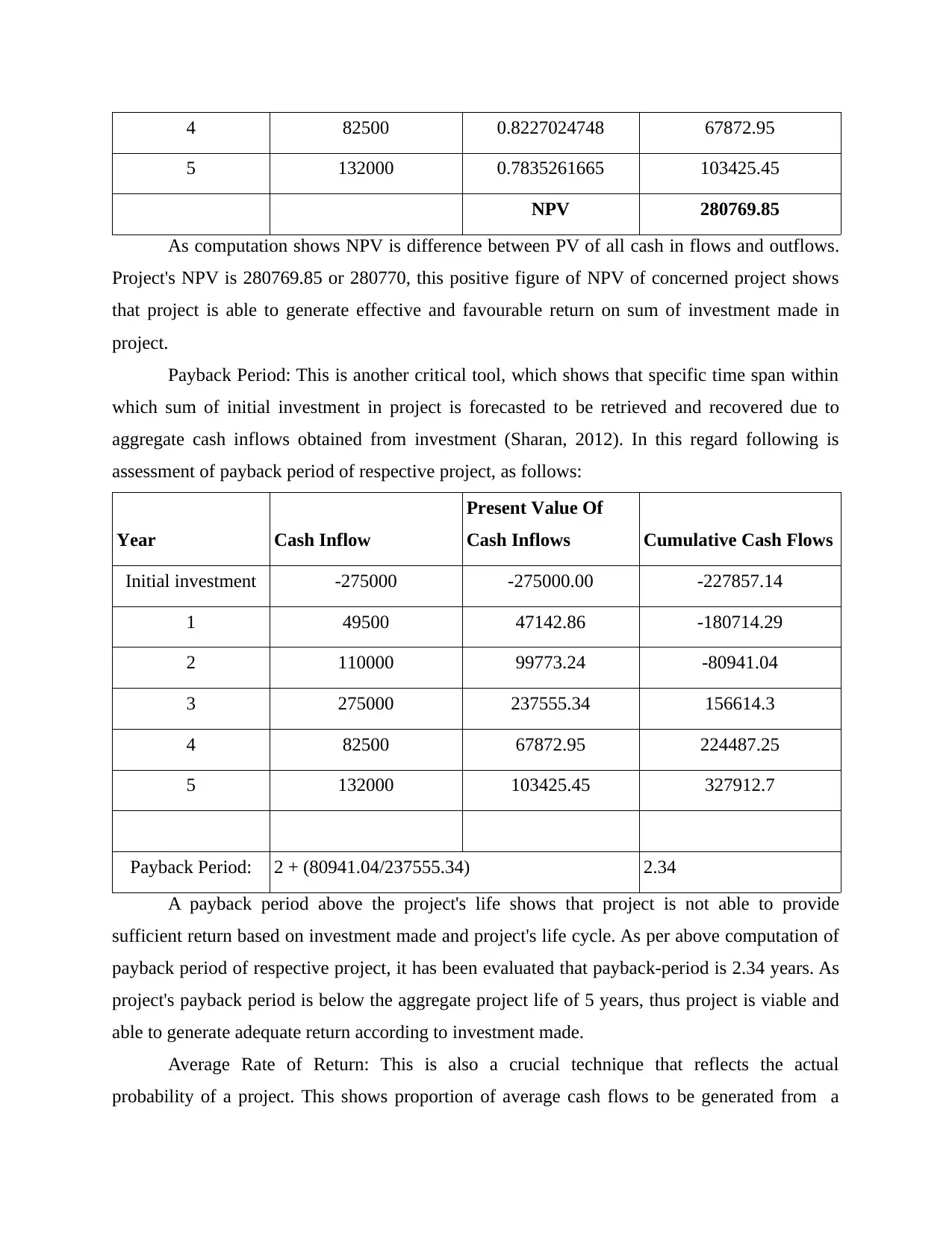
4 82500 0.8227024748 67872.95
5 132000 0.7835261665 103425.45
NPV 280769.85
As computation shows NPV is difference between PV of all cash in flows and outflows.
Project's NPV is 280769.85 or 280770, this positive figure of NPV of concerned project shows
that project is able to generate effective and favourable return on sum of investment made in
project.
Payback Period: This is another critical tool, which shows that specific time span within
which sum of initial investment in project is forecasted to be retrieved and recovered due to
aggregate cash inflows obtained from investment (Sharan, 2012). In this regard following is
assessment of payback period of respective project, as follows:
Year Cash Inflow
Present Value Of
Cash Inflows Cumulative Cash Flows
Initial investment -275000 -275000.00 -227857.14
1 49500 47142.86 -180714.29
2 110000 99773.24 -80941.04
3 275000 237555.34 156614.3
4 82500 67872.95 224487.25
5 132000 103425.45 327912.7
Payback Period: 2 + (80941.04/237555.34) 2.34
A payback period above the project's life shows that project is not able to provide
sufficient return based on investment made and project's life cycle. As per above computation of
payback period of respective project, it has been evaluated that payback-period is 2.34 years. As
project's payback period is below the aggregate project life of 5 years, thus project is viable and
able to generate adequate return according to investment made.
Average Rate of Return: This is also a crucial technique that reflects the actual
probability of a project. This shows proportion of average cash flows to be generated from a
5 132000 0.7835261665 103425.45
NPV 280769.85
As computation shows NPV is difference between PV of all cash in flows and outflows.
Project's NPV is 280769.85 or 280770, this positive figure of NPV of concerned project shows
that project is able to generate effective and favourable return on sum of investment made in
project.
Payback Period: This is another critical tool, which shows that specific time span within
which sum of initial investment in project is forecasted to be retrieved and recovered due to
aggregate cash inflows obtained from investment (Sharan, 2012). In this regard following is
assessment of payback period of respective project, as follows:
Year Cash Inflow
Present Value Of
Cash Inflows Cumulative Cash Flows
Initial investment -275000 -275000.00 -227857.14
1 49500 47142.86 -180714.29
2 110000 99773.24 -80941.04
3 275000 237555.34 156614.3
4 82500 67872.95 224487.25
5 132000 103425.45 327912.7
Payback Period: 2 + (80941.04/237555.34) 2.34
A payback period above the project's life shows that project is not able to provide
sufficient return based on investment made and project's life cycle. As per above computation of
payback period of respective project, it has been evaluated that payback-period is 2.34 years. As
project's payback period is below the aggregate project life of 5 years, thus project is viable and
able to generate adequate return according to investment made.
Average Rate of Return: This is also a crucial technique that reflects the actual
probability of a project. This shows proportion of average cash flows to be generated from a
Paraphrase This Document
Need a fresh take? Get an instant paraphrase of this document with our AI Paraphraser
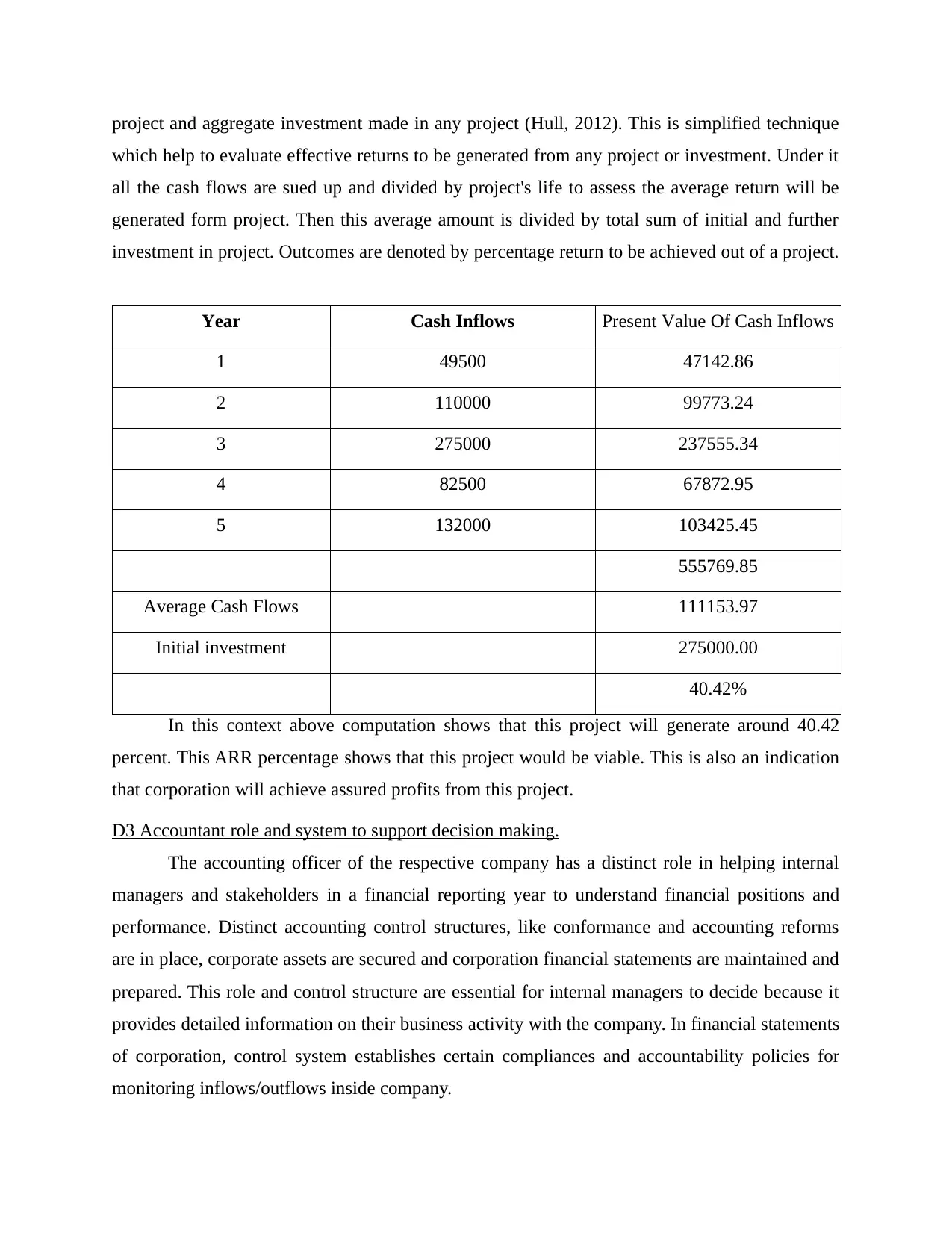
project and aggregate investment made in any project (Hull, 2012). This is simplified technique
which help to evaluate effective returns to be generated from any project or investment. Under it
all the cash flows are sued up and divided by project's life to assess the average return will be
generated form project. Then this average amount is divided by total sum of initial and further
investment in project. Outcomes are denoted by percentage return to be achieved out of a project.
Year Cash Inflows Present Value Of Cash Inflows
1 49500 47142.86
2 110000 99773.24
3 275000 237555.34
4 82500 67872.95
5 132000 103425.45
555769.85
Average Cash Flows 111153.97
Initial investment 275000.00
40.42%
In this context above computation shows that this project will generate around 40.42
percent. This ARR percentage shows that this project would be viable. This is also an indication
that corporation will achieve assured profits from this project.
D3 Accountant role and system to support decision making.
The accounting officer of the respective company has a distinct role in helping internal
managers and stakeholders in a financial reporting year to understand financial positions and
performance. Distinct accounting control structures, like conformance and accounting reforms
are in place, corporate assets are secured and corporation financial statements are maintained and
prepared. This role and control structure are essential for internal managers to decide because it
provides detailed information on their business activity with the company. In financial statements
of corporation, control system establishes certain compliances and accountability policies for
monitoring inflows/outflows inside company.
which help to evaluate effective returns to be generated from any project or investment. Under it
all the cash flows are sued up and divided by project's life to assess the average return will be
generated form project. Then this average amount is divided by total sum of initial and further
investment in project. Outcomes are denoted by percentage return to be achieved out of a project.
Year Cash Inflows Present Value Of Cash Inflows
1 49500 47142.86
2 110000 99773.24
3 275000 237555.34
4 82500 67872.95
5 132000 103425.45
555769.85
Average Cash Flows 111153.97
Initial investment 275000.00
40.42%
In this context above computation shows that this project will generate around 40.42
percent. This ARR percentage shows that this project would be viable. This is also an indication
that corporation will achieve assured profits from this project.
D3 Accountant role and system to support decision making.
The accounting officer of the respective company has a distinct role in helping internal
managers and stakeholders in a financial reporting year to understand financial positions and
performance. Distinct accounting control structures, like conformance and accounting reforms
are in place, corporate assets are secured and corporation financial statements are maintained and
prepared. This role and control structure are essential for internal managers to decide because it
provides detailed information on their business activity with the company. In financial statements
of corporation, control system establishes certain compliances and accountability policies for
monitoring inflows/outflows inside company.
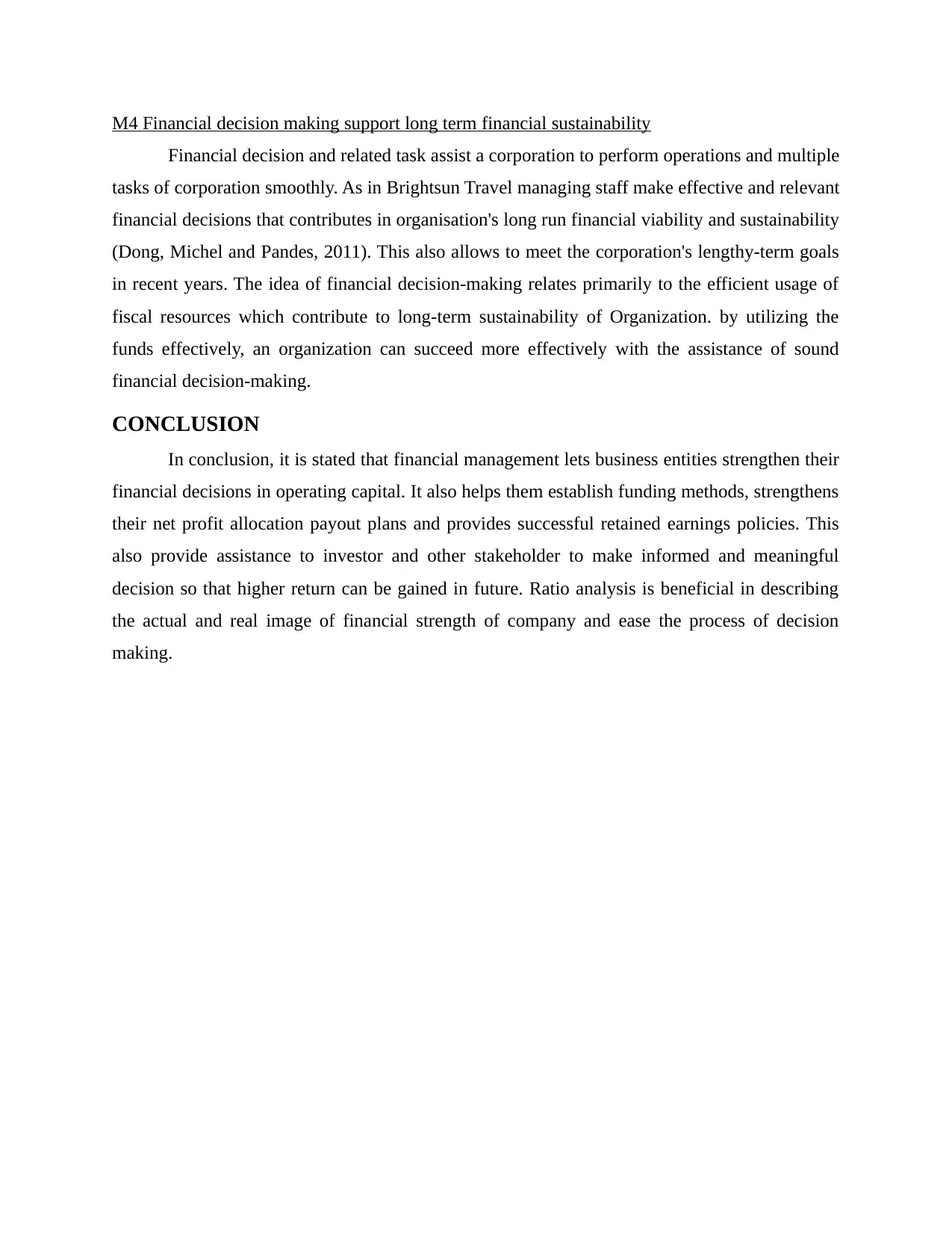
M4 Financial decision making support long term financial sustainability
Financial decision and related task assist a corporation to perform operations and multiple
tasks of corporation smoothly. As in Brightsun Travel managing staff make effective and relevant
financial decisions that contributes in organisation's long run financial viability and sustainability
(Dong, Michel and Pandes, 2011). This also allows to meet the corporation's lengthy-term goals
in recent years. The idea of financial decision-making relates primarily to the efficient usage of
fiscal resources which contribute to long-term sustainability of Organization. by utilizing the
funds effectively, an organization can succeed more effectively with the assistance of sound
financial decision-making.
CONCLUSION
In conclusion, it is stated that financial management lets business entities strengthen their
financial decisions in operating capital. It also helps them establish funding methods, strengthens
their net profit allocation payout plans and provides successful retained earnings policies. This
also provide assistance to investor and other stakeholder to make informed and meaningful
decision so that higher return can be gained in future. Ratio analysis is beneficial in describing
the actual and real image of financial strength of company and ease the process of decision
making.
Financial decision and related task assist a corporation to perform operations and multiple
tasks of corporation smoothly. As in Brightsun Travel managing staff make effective and relevant
financial decisions that contributes in organisation's long run financial viability and sustainability
(Dong, Michel and Pandes, 2011). This also allows to meet the corporation's lengthy-term goals
in recent years. The idea of financial decision-making relates primarily to the efficient usage of
fiscal resources which contribute to long-term sustainability of Organization. by utilizing the
funds effectively, an organization can succeed more effectively with the assistance of sound
financial decision-making.
CONCLUSION
In conclusion, it is stated that financial management lets business entities strengthen their
financial decisions in operating capital. It also helps them establish funding methods, strengthens
their net profit allocation payout plans and provides successful retained earnings policies. This
also provide assistance to investor and other stakeholder to make informed and meaningful
decision so that higher return can be gained in future. Ratio analysis is beneficial in describing
the actual and real image of financial strength of company and ease the process of decision
making.
⊘ This is a preview!⊘
Do you want full access?
Subscribe today to unlock all pages.

Trusted by 1+ million students worldwide
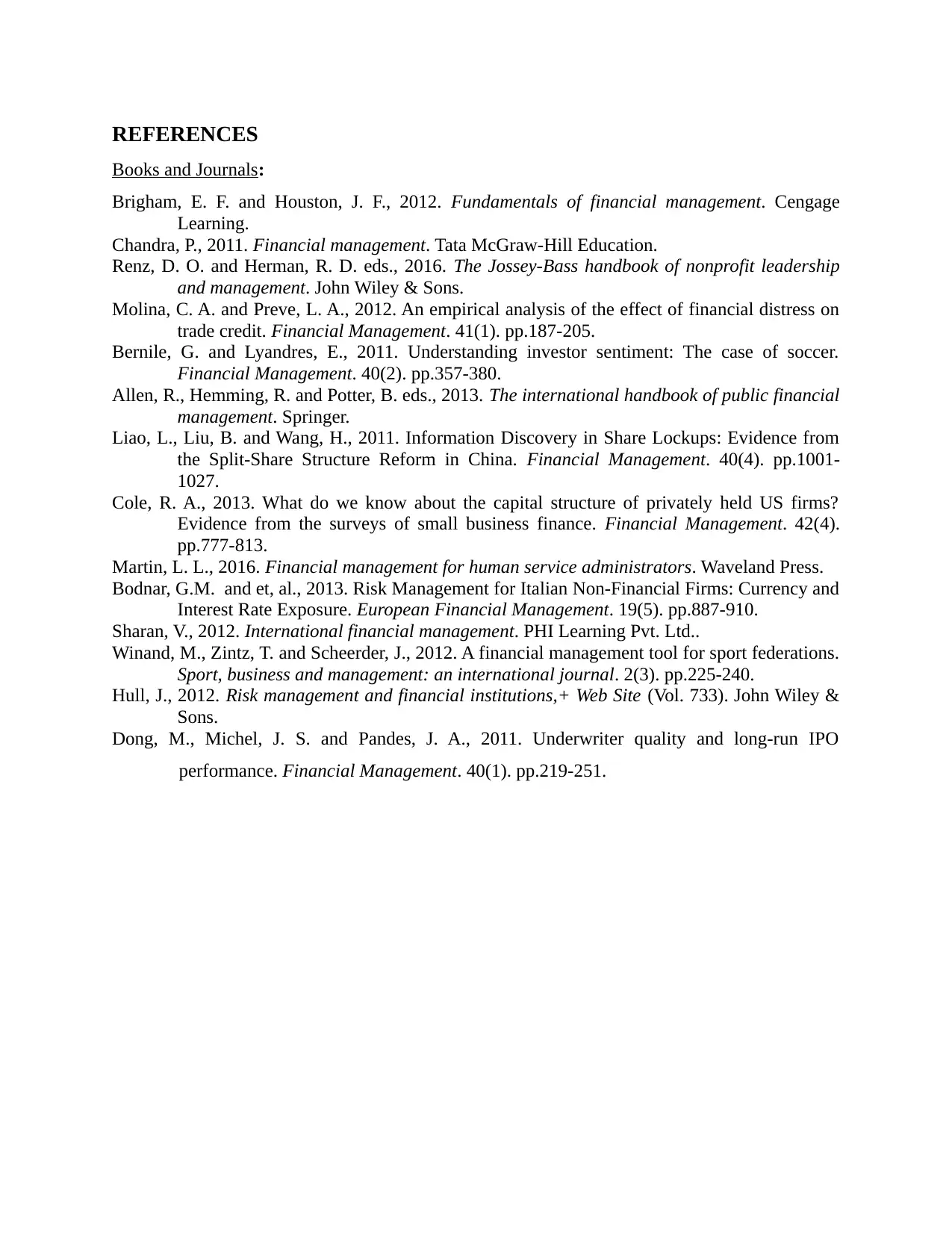
REFERENCES
Books and Journals:
Brigham, E. F. and Houston, J. F., 2012. Fundamentals of financial management. Cengage
Learning.
Chandra, P., 2011. Financial management. Tata McGraw-Hill Education.
Renz, D. O. and Herman, R. D. eds., 2016. The Jossey-Bass handbook of nonprofit leadership
and management. John Wiley & Sons.
Molina, C. A. and Preve, L. A., 2012. An empirical analysis of the effect of financial distress on
trade credit. Financial Management. 41(1). pp.187-205.
Bernile, G. and Lyandres, E., 2011. Understanding investor sentiment: The case of soccer.
Financial Management. 40(2). pp.357-380.
Allen, R., Hemming, R. and Potter, B. eds., 2013. The international handbook of public financial
management. Springer.
Liao, L., Liu, B. and Wang, H., 2011. Information Discovery in Share Lockups: Evidence from
the Split‐Share Structure Reform in China. Financial Management. 40(4). pp.1001-
1027.
Cole, R. A., 2013. What do we know about the capital structure of privately held US firms?
Evidence from the surveys of small business finance. Financial Management. 42(4).
pp.777-813.
Martin, L. L., 2016. Financial management for human service administrators. Waveland Press.
Bodnar, G.M. and et, al., 2013. Risk Management for Italian Non‐Financial Firms: Currency and
Interest Rate Exposure. European Financial Management. 19(5). pp.887-910.
Sharan, V., 2012. International financial management. PHI Learning Pvt. Ltd..
Winand, M., Zintz, T. and Scheerder, J., 2012. A financial management tool for sport federations.
Sport, business and management: an international journal. 2(3). pp.225-240.
Hull, J., 2012. Risk management and financial institutions,+ Web Site (Vol. 733). John Wiley &
Sons.
Dong, M., Michel, J. S. and Pandes, J. A., 2011. Underwriter quality and long‐run IPO
performance. Financial Management. 40(1). pp.219-251.
Books and Journals:
Brigham, E. F. and Houston, J. F., 2012. Fundamentals of financial management. Cengage
Learning.
Chandra, P., 2011. Financial management. Tata McGraw-Hill Education.
Renz, D. O. and Herman, R. D. eds., 2016. The Jossey-Bass handbook of nonprofit leadership
and management. John Wiley & Sons.
Molina, C. A. and Preve, L. A., 2012. An empirical analysis of the effect of financial distress on
trade credit. Financial Management. 41(1). pp.187-205.
Bernile, G. and Lyandres, E., 2011. Understanding investor sentiment: The case of soccer.
Financial Management. 40(2). pp.357-380.
Allen, R., Hemming, R. and Potter, B. eds., 2013. The international handbook of public financial
management. Springer.
Liao, L., Liu, B. and Wang, H., 2011. Information Discovery in Share Lockups: Evidence from
the Split‐Share Structure Reform in China. Financial Management. 40(4). pp.1001-
1027.
Cole, R. A., 2013. What do we know about the capital structure of privately held US firms?
Evidence from the surveys of small business finance. Financial Management. 42(4).
pp.777-813.
Martin, L. L., 2016. Financial management for human service administrators. Waveland Press.
Bodnar, G.M. and et, al., 2013. Risk Management for Italian Non‐Financial Firms: Currency and
Interest Rate Exposure. European Financial Management. 19(5). pp.887-910.
Sharan, V., 2012. International financial management. PHI Learning Pvt. Ltd..
Winand, M., Zintz, T. and Scheerder, J., 2012. A financial management tool for sport federations.
Sport, business and management: an international journal. 2(3). pp.225-240.
Hull, J., 2012. Risk management and financial institutions,+ Web Site (Vol. 733). John Wiley &
Sons.
Dong, M., Michel, J. S. and Pandes, J. A., 2011. Underwriter quality and long‐run IPO
performance. Financial Management. 40(1). pp.219-251.
1 out of 10
Related Documents
Your All-in-One AI-Powered Toolkit for Academic Success.
+13062052269
info@desklib.com
Available 24*7 on WhatsApp / Email
![[object Object]](/_next/static/media/star-bottom.7253800d.svg)
Unlock your academic potential
Copyright © 2020–2025 A2Z Services. All Rights Reserved. Developed and managed by ZUCOL.





